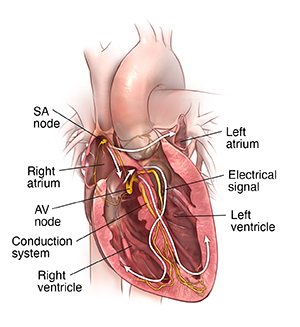Anatomy and Function of the Electrical System
The heart's electrical system
In the simplest of terms, the heart is a pump made up of muscle tissue. The heart's pumping action is controlled by an electrical conduction system that coordinates the contraction of the heart chambers.
How does the heart beat?
An electrical stimulus is generated in a special part of the heart muscle called the sinus node. It's also called the sinoatrial node (SA node). The sinus node is a small mass of special tissue in the right upper chamber of the heart (right atrium). In an adult, the sinus node sends out a regular electrical pulse 60 to 100 times per minute. This electrical pulse travels down through the conduction pathways. It causes the heart's lower chambers (ventricles) to contract and pump out blood. The right and left atria are stimulated first. They contract to push blood from the atria into the ventricles. The ventricles then contract to push blood out into the blood vessels of the body.
The original electrical impulse travels from the sinus node across the cells of your heart's right and left atria. The signal travels to the AV node (atrioventricular node). This node is between the atria and the ventricles. In the AV node, the impulses are slowed down for a very short time. This allows the atria to contract a fraction of a second before the ventricles. The blood from the atria empties into the ventricles before the ventricles contract. After passing through the AV node, the electrical current then goes down the conduction pathway. It goes through a pathway called the bundle of His, and into the ventricles. The bundle of His divides into right and left pathways (bundle branches) to give electrical stimulation to the right and left ventricles.
Normally at rest, the heart contracts about 60 to 100 times a minute depending on your age. In general, your heart rate slows as you age.

What can go wrong with the heart's electrical system?
Under some abnormal conditions, certain heart tissue is capable of starting a heartbeat, or becoming the "pacemaker," just like the sinus node. An abnormal heartbeat (arrhythmia) may occur when:
-
The heart's natural pacemaker (the sinus node) becomes diseased and slows down
-
The normal conduction pathway is interrupted
-
Another part of the heart takes over as pacemaker. This causes a faster or slower heartbeat.
Symptoms of an arrhythmia can include a feeling that your heart is fluttering (heart palpitations), shortness of breath, dizziness, or fainting.
You may need an ECG (electrocardiogram) to assess the rhythm of the heart. This painless test records the electrical activity of your heart with several small stickers attached to your chest. If the electrical rhythm is abnormal, you may need to be prescribed medicine. Or you may need a procedure to further investigate the cause or correct the rhythm.


